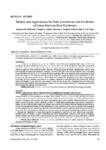Please use this identifier to cite or link to this item:
http://www.alice.cnptia.embrapa.br/alice/handle/doc/469959| Title: | Models and applications for risk assessment and prediction of Asian soybean rust epidemics. |
| Authors: | DEL PONTE, E. M.  GODOY, C. V.   CANTERI, M. G.   REIS, E. M.   YANG, X. B.   |
| Date Issued: | 2006 |
| Citation: | Fitopatologia Brasileira, Brasília, DF, v.31, n. 6, p. 533-544, Nov./Dec. 2006. |
| Description: | Asian rust of soybean [Glycine max (L.) Merril] is one of the most important fungal diseases of this crop worldwide. The recent introduction of Phakopsora pachyrhizi Syd. & P. Syd in the Americas represents a major threat to soybean production in the main growing regions, and significant losses have already been reported. P. pachyrhizi is extremely aggressive under favorable weather conditions, causing rapid plant defoliation. Epidemiological studies, under both controlled and natural environmental conditions, have been done for several decades with the aim of elucidating factors that affect the disease cycle as a basis for disease modeling. The recent spread of Asian soybean rust to major production regions in the world has promoted new development, testing and application of mathematical models to assess the risk and predict the disease. These efforts have included the integration of new data, epidemiological knowledge, statistical methods, and advances in computer simulation to develop models and systems with different spatial and temporal scales, objectives and audience. In this review, we present a comprehensive discussion on the models and systems that have been tested to predict and assess the risk of Asian soybean rust. Limitations, uncertainties and challenges for modelers are also discussed. |
| Keywords: | Soybean |
| Type of Material: | Artigo de periódico |
| Access: | openAccess |
| Appears in Collections: | Artigo em periódico indexado (CNPSO)  |










